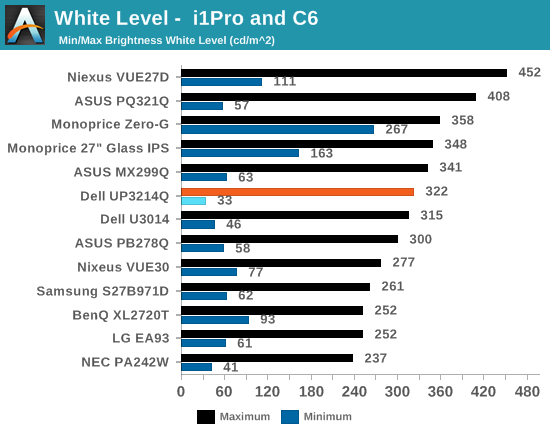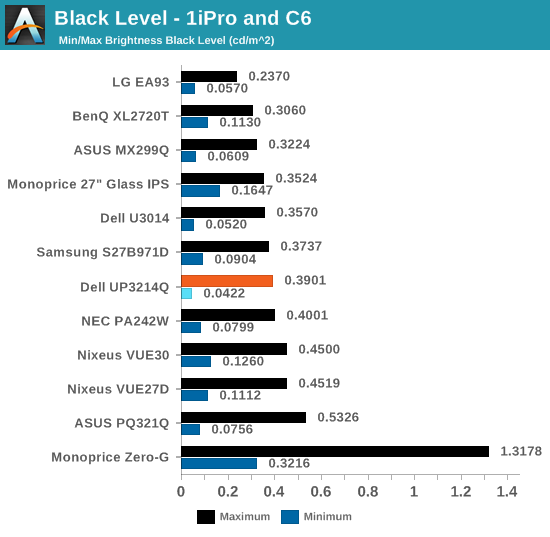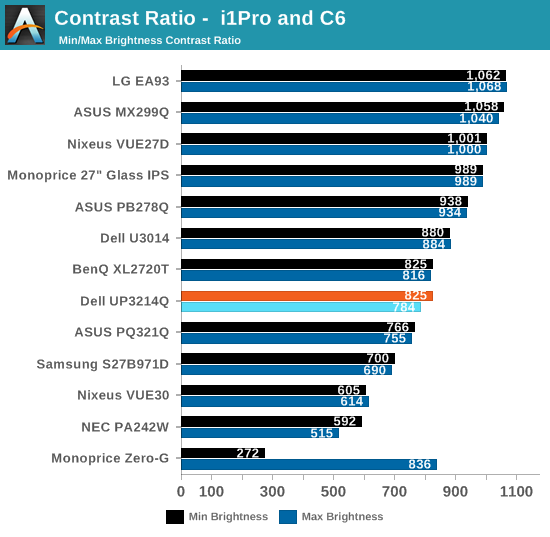Dell UP3214Q Review
by Chris Heinonen on April 1, 2014 12:00 AM ESTWith the backlight set to maximum in sRGB mode I measure 322 cd/m2 of brightness with a pure white screen on the UP3214Q. Setting the backlight to minimum results in a reading of 33 cd/m2. I could possibly use a different color preset to get a higher reading, but that usually means tinted whites and a loss of dynamic range, so I prefer to stick to the maximum value you would want in a real world setting.

Using the same test setup for black levels, the Dell emits 0.3901 cd/m2 of light with the backlight at maximum and 0.0422 cd/m2 with the backlight at minimum.

Combined, we get contrast ratios around 800:1. In comparison to the only other UltraHD display reviewed to this point, the ASUS PQ321Q, the Dell has a slightly higher contrast ratio but a slightly lower maximum light output. I believe the combination on the Dell is better for most people as going past 300 cd/m2 produces an image most people find too bright but everyone can utilize a higher contrast ratio. That said, the contrast ratio difference isn’t huge, as you can see.

UltraHD displays are still lagging behind QHD displays when it comes to contrast ratio, as those are approaching 1,100:1 now. It isn’t bad, but it’s also an area that hopefully can improve over the next year or two as better panels become available.










84 Comments
View All Comments
Taracta - Tuesday, April 1, 2014 - link
I don't know what is considered by many as HiDPI but this monitor is most definitely not HiDPI at just 140 DPI! I know that most highend monitors are ~ 100 DPI and common one are even lower but I don't see why 140 DPI would be such a big deal. Are the Icons that much smaller? Are the alphanumeric character unreadable?I believe the the ridiculously low DPI of generations of monitor has made expectation of huge icons and lettering the norm and they are just not needed. You can see the icons and characters perfectly fine at 140DPI no scaling is needed!
houkouonchi - Friday, April 4, 2014 - link
Yeah I think its just people set in their ways. Even when I had an out-dated prescription and saw worse than 20/20 I still would have no problem with that size. The only thing I can think of is that is just how most people have used computers and are stuck in their ways. I used 1600x1200 on a 17 inch CRT way back in the days (pre windows-2000) and soon after when I switched to linux I was 2560x1920 on a 22 inch CRT. It was even a bit blurry but it was still not a problem and that was 160 PPI. With a super sharp 140 PPI display why do people need scaling? I don't use scaling even on a 200 PPI+ display.JDG1980 - Tuesday, April 1, 2014 - link
Personally, I'd like to see a 39" 4K monitor, using the same VA panel in the Seiki TV but with a 60 Hz input. The Seiki TV is OK for productivity apps, but if you play any games or watch videos, as I do, then the low frame rate is a deal-breaker.A 39" monitor at 4K would provide an absolutely huge workspace - you would no longer need a multiple monitor setup. And the DPI isn't much higher than a standard 27" 2560x1440 monitor, so you don't need to use the Windows scaling that so many applications still don't do properly. (Microsoft really needs to do something about this - right now they seem content just to hope everyone eventually moves to Metro, which they aren't and won't.)
sk317bge - Tuesday, April 1, 2014 - link
Chris H. - does the Dell preset for Game exist? On my 24", the Game mode has less lag (by many milliseconds), with a tradeoff that the color is a bit too overdriven.GTVic - Tuesday, April 1, 2014 - link
May be UltraHD in comparison to a TV, but 138 DPI is something I would sneeze at. A 50% increase in pixel density compared to a standard 16:10 24" monitor with 94 DPI is not enough.lokitx - Tuesday, April 1, 2014 - link
Everyone should read this before purchasing this monitor: http://en.community.dell.com/support-forums/periph...praeses - Tuesday, April 1, 2014 - link
You mention the usefulness of contrast over brightness in this instance. As LED monitors do lose a notable amount of brightness over time, are you able to re-test the brightness of a monitor that you have previously tested and recorded the numbers on and report the differences?I suspect over the long term having a monitor that can go brighter than needed may be more useful than suspected.
Human Bass - Tuesday, April 1, 2014 - link
It was looking quite decent, but that lag, wow, seems like a motion blur city.cjl - Wednesday, April 2, 2014 - link
Lag does not cause motion blur. Lag is how long a display takes to react to an input, and is usually (in the case of displays like this) caused by a delay in the image processing circuitry in the display itself. Motion blur on the other hand would be caused by a slow pixel response time (where the pixels themselves take a long time to change states after the display has already begun to refresh).Death666Angel - Tuesday, April 1, 2014 - link
I'm more looking for the 28" Dell one, much better price/performance for me. 600€ is nearly as much as I paid for my 1440p monitor not that long ago. Incredible.